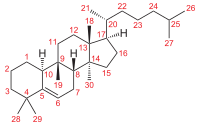葫芦素


葫芦素(英语:Cucurbitacin)是一类生物化学复合物中的任何一种,某些植物-尤其是葫芦科(Cucurbitaceae)的成员,其包括普通的南瓜和葫芦-生产并用作对食草动物的防御。葫芦素在化学上被分类为甾体,形式上衍生自葫芦烷,是一种特定的三萜烃,衍生自不饱和变体的葫芦巴-5-烯(cucurbita-5-ene),或19-(10→9β)-白-10-烯醇-5-烯(19-(10→9β)-abeo-10α-lanost-5-ene)。它们经常以糖苷形式出现[1]。它们和它们的衍生物已经被发现存在于许多植物科中(包括十字花科,葫芦科,玄参科,秋海棠科,毛茛科,Datisca,离水花科,毛茛科,报春花科,茜草科,梧桐科,蔷薇科,和瑞香科),在一些蘑菇(包括红菇和希伯洛马)中和甚至在一些海洋软体动物中。
葫芦素可能是在某些动物采食的植物中和在一些人类喜欢的可食用植物(如黄瓜)中具有的味觉威慑力。在实验室研究中,葫芦素具有细胞毒性,其潜在的生物活性正在被研究[2][3]。
葫芦素是从中药中提取,可治疗肝炎及肝癌[4][5][来源可靠?] ,存在于深绿色果类或果蒂部位,但误食过量会有恶心、呕吐、腹泻等胃肠道症状[6] 。然而中药方如瓜蒂散,正是取其催吐作用。
生物合成[编辑]
葫芦素C的生物合成已经被张等人(2014)描述了。 在葫芦素C的生物合成途径中鉴定了9个黄瓜基因,并阐明了4个催化步骤[7]。 这些作者还发现了分别在叶子和果实中调节该通路的转录因子 Bl(苦叶)和 Bt(苦果)。Bi 基因赋予整个植物苦味,并且在遗传上与类操纵子基因簇相关,类似于拟南芥属中涉及拟南芥生物合成的基因簇。 果实中苦味需要 Bi 和显性 Bt(苦果)基因。 栽培黄瓜果实的无苦味是由 bt 赋予的,bt 是在驯化过程中选择的等位基因。 Bi 是氧化鲨烯环化酶 (OSC) 基因家族的成员。 系统发育分析表明,Bi 是南瓜 (美洲南瓜,Cucurbita pepo) 中葫芦二烯醇合酶基因 CPQ 的直系同源物[7]。
研究和毒性[编辑]
葫芦素的生物学特性正在进行基础研究,包括毒性和潜在药理学用途,用于开发治疗炎症、癌症、心血管疾病和糖尿病等药物[1][2][3][8]。
与食用葫芦素含量高的食物相关的毒性有时被称为“有毒葫芦综合症”[9][10]。 2018 年在法国,两名妇女吃了苦南瓜汤后生病,包括恶心、呕吐和腹泻,几周后脱发[11]。 法国另一项关于食用苦南瓜属中毒的研究发现了类似的急性疾病,但没有死亡病例[12]。 植物中高浓度的毒素可能是由于与野生葫芦科植物异花授粉[13],或由于高温和干旱导致的植物生长胁迫[14]。
参考资料[编辑]
- ^ 1.0 1.1 Jian Chao Chen, Ming Hua Chiu, Rui Lin Nie, Geoffrey A. Cordell and Samuel X. Qiu (2005), "Cucurbitacins and cucurbitane glycosides: structures and biological activities" Natural Product Reports, volume 22, pages 386-399 doi:10.1039/B418841C
- ^ 2.0 2.1 Alghasham, AA. Cucurbitacins - a promising target for cancer therapy. International Journal of Health Sciences. 2013, 7 (1): 77–89. PMC 3612419
 . PMID 23559908. doi:10.12816/0006025.
. PMID 23559908. doi:10.12816/0006025.
- ^ 3.0 3.1 Kapoor, S. Cucurbitacin B and Its Rapidly Emerging Role in the Management of Systemic Malignancies Besides Lung Carcinomas. Cancer Biotherapy and Radiopharmaceuticals. 2013, 28 (4): 359. PMID 23350897. doi:10.1089/cbr.2012.1373.
- ^ 甲型病毒性肝炎防治知识问答. 2003.
- ^ 養生飲食:八大食物可以殺死癌細胞. 2013-07-03.
- ^ 有毒中草药大辞典. 1992.
- ^ 7.0 7.1 Shang Y, Ma Y, Zhou Y, Zhang H, Duan L, Chen H, et al. Plant science. Biosynthesis, regulation, and domestication of bitterness in cucumber. Science. November 2014, 346 (6213): 1084–8. Bibcode:2014Sci...346.1084S. PMID 25430763. S2CID 206561241. doi:10.1126/science.1259215.
- ^ Kaushik U, Aeri V, Mir SR. Cucurbitacins - An insight into medicinal leads from nature. Pharmacognosy Reviews. 2015, 9 (17): 12–8. PMC 4441156
 . PMID 26009687. doi:10.4103/0973-7847.156314.
. PMID 26009687. doi:10.4103/0973-7847.156314.
- ^ Kusin S, Angert T, von Derau K, Horowitz BZ, Giffin S. 189. Toxic Squash Syndrome: A case series of diarrheal illness following ingestion of bitter squash, 1999-2011. 2012 Annual Meeting of the North American Congress of Clinical Toxicology (NACCT) October 1–6, 2012 las Vegas, NV, USA. Clinical Toxicology. 2012, 50 (7): 574–720. doi:10.3109/15563650.2012.700015
 .
.
- ^ Poisoned by Bitter Squash, Two Women Lose Their Hair. Live Science. March 28, 2018 [2023-06-10]. (原始内容存档于2023-06-10).
- ^ Assouly P. Hair Loss Associated With Cucurbit Poisoning. JAMA Dermatology. May 2018, 154 (5): 617–618. PMID 29590275. doi:10.1001/jamadermatol.2017.6128.
- ^ Le Roux G, Leborgne I, Labadie M, Garnier R, Sinno-Tellier S, Bloch J, et al. Poisoning by non-edible squash: retrospective series of 353 patients from French Poison Control Centers. Clinical Toxicology. August 2018, 56 (8): 790–794. PMID 29323540. S2CID 29978562. doi:10.1080/15563650.2018.1424891.
- ^ Rymal KS, Chambliss OL, Bond MD, Smith DA. Squash Containing Toxic Cucurbitacin Compounds Occurring in California and Alabama. Journal of Food Protection. April 1984, 47 (4): 270–271. PMID 30921968. doi:10.4315/0362-028X-47.4.270
 .
.
- ^ Mashilo J, Odindo AO, Shimelis HA, Musenge P, Tesfay SZ, Magwaza LS. Photosynthetic response of bottle gourd [Lagenaria siceraria (Molina) Standl.] to drought stress: Relationship between cucurbitacins accumulation and drought tolerance. Scientia Horticulturae. 2018, 231: 133–143. S2CID 89836386. doi:10.1016/j.scienta.2017.12.027.
